1) THE PRESIDENT'S CORNER (by Tom Steichen)
 Well,
we are not virus free yet... in fact, in many places we are worse off now than a month ago, as the inevitable rise in cases
has followed the reopening of economies and the rebellion against face masks by the "it's all about me" crowd. I'll throw
out an opinion here: I do think we need to reopen the economy in a sensible way ...but I also think face masks should
be mandatory in every indoor public space (including private places open to the public) and that those spaces should
be required to have hand-sanitizer dispensers near high-touch areas. We need income, but we must look out for
each other too [end of mini manifesto]. Well,
we are not virus free yet... in fact, in many places we are worse off now than a month ago, as the inevitable rise in cases
has followed the reopening of economies and the rebellion against face masks by the "it's all about me" crowd. I'll throw
out an opinion here: I do think we need to reopen the economy in a sensible way ...but I also think face masks should
be mandatory in every indoor public space (including private places open to the public) and that those spaces should
be required to have hand-sanitizer dispensers near high-touch areas. We need income, but we must look out for
each other too [end of mini manifesto].
With the return of exponentially rising case counts, I've decided to call this my redux edition (redux,
adjective: brought back; revived), as it seems everything in this newsletter reprises things published in recent
editions.
This month's redux collection of bits and pieces (Article 1) begins with a return to our Güssing births-transcription
commentary (presented by two tidbits last month) with two more tidbits that talk about additional improvements to the
transcriptions and resolution of many of my confusions about the Mayerhofs and other outlying facilities in the Güssing
hotter. Speaking of recurring confusions. Next we redux report on a correction to
our FS Films section, one initiated from our Facebook page... it appears we had an incorrect civil
recording location for Unterschützen... which has now been fixed! Then we revive (for, hopefully, the last time) the
monthly update on the "corona virus epidemic in Austria" as contrasted by two US states.
We close with our regular tidbit features (being regular, they are "redux" by their very nature): the monthly BB Facebook
report, book sales, a recipe and a humor item.
Article 2 is by Patricia Nemetz-Mills. You may recall that this newsletter encouraged you to
participate in a Study she was running about Culture, Nostalgia and Modern Migration among
Burgenländers and their Descendants. That study is now complete and, as promised, Patricia is sharing a report about
it with us. I hope you enjoy and are enlightened by it.
The remaining articles are our standard sections: Historical Newsletter Articles, (no) Ethnic Events
and Emigrant Obituaries.

Güssing RC Baptisms Transcription (Redux): In last month's newsletter, we announced a transcription of
birth/baptism records for the Catholic parish of Güssing (Németujvár) for the 1861-1895
era, a transcription for which we provided a "raw" transcription—being our best effort to transcribe exactly
what was written—and a "standard" transcription, wherein we converted all "obvious" variations of a family
name to a single "convenient" version for a given family and wherein we made many editorial changes correcting what seemed
to be obvious errors. We also noted the absence of all images and their records for 1890 and of some images/records for
other years.
BB staff member Klaus Gerger, being a Güssing native, said he was "absolutely stunned" to see a Güssing
transcription, and immediately offered improvements, including the missing images/pages and commentary on the Meierhofs.
In fact, though, he went well beyond his original offer: I received a full transcription (from the originals) of the missing
records plus additional help in standardizing the records. Klaus was able to say (especially for V/W surnames) which
versions have become the most common in Güssing today, as well as to identify (and correct) quite a few remaining
transcribed names "which sounded strange" to him in light of his knowledge of Güssing family names. All of these
corrections (including switching to his proposed "convenience" surname versions), as well as the additional 149 records from
missing images, have been incorporated into the "standard" transcription (but not the "raw" transcription, as they
made no sense there). Klaus also provided information to resolve my confusion about the various Meierhofs... but we cover
that in the next tidbit!
You can access the online transcription(s) directly via this link:
GüssingRecords or by following
the links starting from our Vital Records
Transcriptions link found on the BB homepage.

Güssing Births Transcription -- Things Discovered Along The Way (Redux): Last month I reported some of the
"surprises" discovered while doing the Güssing births transcription... and I noted those in a "bit" with this same title.
The portion about the Güssing Maierhofs / Mayerhofs drew some quite useful responses from BB members, and
those responses helped clear my confusion about these places and the conscription numbers assigned to them. Let me
explain...
I claimed that the Mayerhofs were working farms in the outlying areas of the Güssing hotter that were owned by
the Batthyány nobility (Philip and Christopher), and that they also were residences for a fair number of families through
the years. Further, that the two main ones were Ludwigshof and Zsánkoháza, with Ludwigshof
in the far northern end of the hotter and Zsánkoháza in the southeast corner, and that both consisted of
multiple facilities, with the parts separated from each other by short distances.
All of those claims were quite accurate... however, when I got into more-specific details and tried to tie them to
conscription numbers, well, that is where my confusion and resulting inaccuracy came in! So let me see if I can now
(accurately) sort all this out for you.
Credit for my enlightenment goes to Werner Stubits, for information about places Abdeckerey and
Cecinowic, and to Klaus Gerger, for providing the Parzellen Protocolle for Güssing that let me
understand and correct almost all of my remaining confusion about the Mayerhofs.
I'll also note that Nancy Gloeckler Coughlin wrote (in part) to say about the transcription: "The most
interesting thing was learning about Sankoház, a place I remember my mother and aunts and uncles speaking about." While
her comment did not help me resolve my confusion, it was nice to know someone had previously heard about this place!
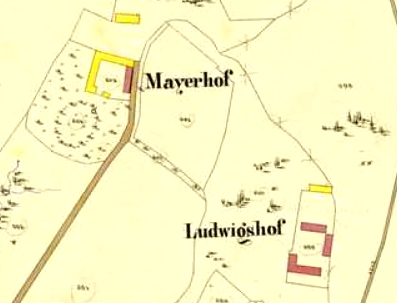 But
let me start dispelling my confusion by speaking about the Parzellen Protocolle... But
let me start dispelling my confusion by speaking about the Parzellen Protocolle...
As you may recall, I included a couple of clips from the 1857 cadastral map showing some of these Mayerhofs;
as an example, one of those clips is shown to the right.
These cadastral maps were created to delineate the boundaries of each piece of land in a Gemeinde. Once a
tract of land was mapped, a "parzelle" (parcel) number was assigned to the piece. If you look closely, you can see
the numbers in the image. Along with the map, a "log" file was created to connect these parzellen numbers to house
(conscription) numbers and their owners... a Parzellen Protocolle is what these log files were called.
So, using the Protocolle information, I created the following table for the outlying facilities and (most of) the
Haus (conscription) numbers that appeared in the Güssing birth records that I associated with one of these places. The
table is sorted by Haus number (as that is what appears in the birth records) and has dividing lines grouping the
facility parts together.
|
Parzelle # |
Haus # |
Owner |
Facility |
| 557 |
95 |
Batthyány, Filip |
Mayerhof (Tómajor) |
| 552 |
96 |
Batthyány, Filip |
Tómajor |
| 192 |
147 |
Batthyány, Filip |
(in town) |
| 208 |
148 |
Batthyány, Filip |
(in town) |
| 191 |
149 |
Batthyány, Filip |
(in town) |
| 188 |
150 |
Batthyány, Christof |
(in town) |
| 482 |
151 |
Batthyány, Christof |
Poltelmayerhof |
| 470 |
152 |
Batthyány, Christof |
Poltelmayerhof |
| 438 |
- |
- |
Zsankaháza |
| 434 |
153 |
Batthyány, Filip |
Oberer Sankohaza |
| 409 |
154 |
Batthyány, Filip |
Unterer Sankohaza |
| 599 |
155 |
Batthyány, Filip |
Ludwigshof |
| 603 |
156 |
Batthyány, Filip |
Mayerhof (Ludwigshof) |
| 528 |
158 |
Csecsinovits, Josef |
Cecinowic |
| 620 |
163 |
Lutterschmeid, Josef |
Abdeckerey |
I parenthetically said "(most of)" in the first sentence before the table because the table does not include all
the Haus numbers that were associated in the birth records with a Mayerhof name. Some proved to be typos by
whomever wrote or copied the original records. Gathering the above information allowed me to recognize these errors and
either flag or correct them in our transcription (those changes have been added to the online transcription).
I'll work through the table from top to bottom... so let me start with Tómajor.

My claim last month was "...there was a Tómajor that appears in the records starting in the later 1880s; it was
associated with house # 96 ...I was not able to discover where it was (as that conscription number has no modern street and
orientation number, implying that it was destroyed and never rebuilt)."
The implication was correct, as no evidence of Tómajor now remains. But comparison of the location of its parzelle
number on the old cadastral map to a modern map let me see that modern addresses Meierhofgasse 2 and 10
plus Raiffeisennstrasse 12 and 14 were built on the site. Further, only a short distance away was a facility
labeled "Mayerhof" that was connected by its parzelle number to Haus number 95 and to the same owner,
Filip Batthyány ...but nowhere did the label "Tómajor" appear ...well, unless you looked really closely:
someone had later faintly handwritten the name onto the map! If you look at the clip below, you can see the
ghostly name above the estate garden/park on the right.
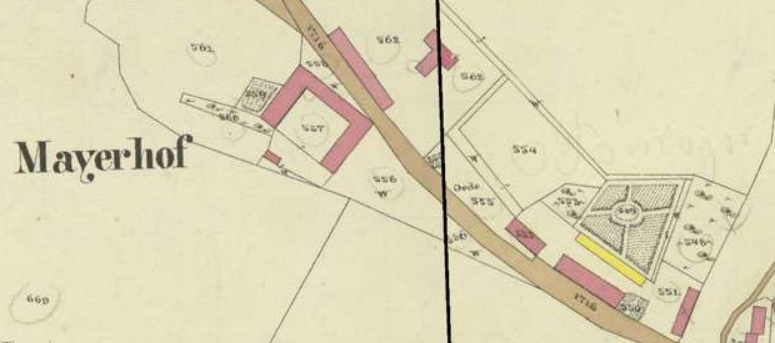
My guess is that inhabitants of Haus 96 were resident gardeners who maintained the property, as parzelle number 552
refers to the leftmost red building near the garden. Other maps labeled these facilities as Teichhof, so my new
speculation is that Tómajor was yet another Magyarization of a too-German sounding name (it appears in the
decade when Magyarization was happening).

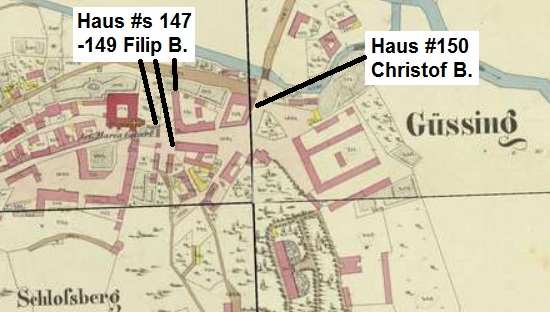 Next,
there are Haus numbers 147 to 150. Next,
there are Haus numbers 147 to 150.
These house numbers were not associated with any Mayerhof in the birth records (except for 150, which appears 5 times
with the Sankoház label!). I recorded 147-149 while trying to track down Tómajor (presuming any property owned by the
Batthyány was a candidate to be it). I added 150 to this grouping after determining that it had nothing to do with
Zsankaháza, even being owned by the wrong Batthyány!
In fact, though, they appear to be in-town residences of the Batthyány, not Mayerhofs.
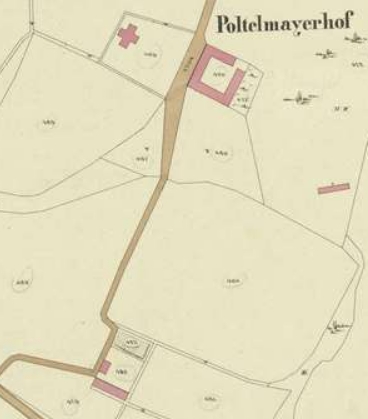 
Haus numbers 151 and 152 proved to be associated with Poltelmayerhof, which also proved to be the only
Güssing Mayerhof owned by Christof Batthyány.
Nonetheless, these Haus numbers were often labeled with (what appeared to be) various Ludwigshof names and/or
Zsankaháza names. I say "appeared to be" because, once the Haus numbers were sorted out and assigned to
specific facilities, it became clear that Lipótmajor was the Magyarization for Poltelmayerhof, not
Ludwigshof! So some of those labels were correct and the confusion over the Lipótmajor name went away.
However, both of these house numbers were also intermittently labeled with Sankoház or Földmajor, an error I
can only ascribe to the priest or the person who made the ledger copy.

The Zsankaháza Haus numbers are the next group. The first thing I discovered via the Protocolle
parzelle number is that the facility labeled Zsankaháza had no house number associated with it.
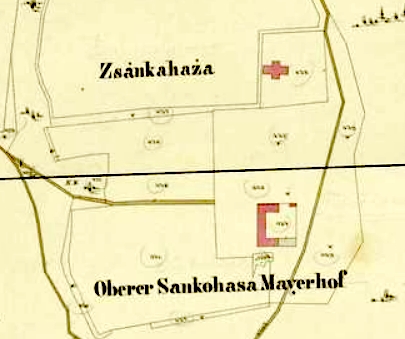 I can
only conclude that it was a non-residential building, possibly a stable or riding arena serviced by staff lodged in the
nearby building labeled Mayerhof. I can
only conclude that it was a non-residential building, possibly a stable or riding arena serviced by staff lodged in the
nearby building labeled Mayerhof.
That facility, Oberer Sankohasa Mayerhof, clearly had Haus number 153 tied to it by the cadastral
map and Protocolle data (and 154, as clearly, was tied to Unterer Sankohasa Mayerhof). However, the
modern map that underlies the cadastral map and even GoogleMaps will label both the Oberer and
Unterer Sankohasa Mayerhofs with both numbers! Despite the modern confusion, it is clear which number belonged to
which facility in 1857!

The Ludwigshof group actually proved to be quite straightforward once I sorted out all the things that were
not associated with it.
 Last
month, I observed that house numbers 151-153, 155-156 and 175 appeared
to be associated with Ludwigshof; further that a facilities named Cecinowic (Haus 158) and
Abdeckerey (Haus 163) appeared to be associated with Ludwigshof (mostly due to proximity). Well, it turned out
proximity was the only association, as they had no real relationship to Ludwigshof and were not even owned
by a Batthyány... I'll speak more on those places below. Last
month, I observed that house numbers 151-153, 155-156 and 175 appeared
to be associated with Ludwigshof; further that a facilities named Cecinowic (Haus 158) and
Abdeckerey (Haus 163) appeared to be associated with Ludwigshof (mostly due to proximity). Well, it turned out
proximity was the only association, as they had no real relationship to Ludwigshof and were not even owned
by a Batthyány... I'll speak more on those places below.
I also already sorted out the Lipótmajor vs. Lajosmajor name confusion (the first belonging to
Poltelmayerhof). So that leaves all the other Haus numbers. Haus 175 was tied to a Langzeil parzelle
number by the Protocolle, so it could not be associated with Ludwigshof (they are far apart!). Alter exploring
the names of the people in the records claiming Ludwigshof 175, it became clear that 175 was a typo for 155 (a legit
Ludwigshof number).
Numbers 151 and 152 belonged to Poltelmayerhof and 153 to Oberer Sankohasa Mayerhof, leaving just 155
and 156 for Ludwigshof. Number 155 proved to be the Ludwigshof-labeled facility on the map above and 156 with
the associated Mayerhof-labeled buildings (which were also called Schafhof on some maps). Lastly, even though
the priest slid in an occasional Latin version, Ludovi(cus), for the name of Ludwigshof, I decided to change
those to the standard name in our transcription... one less thing to confuse users!

Cecinowic (Haus 158) became rather self-evident once I saw the data in the Parzellen Protocolle
for it:
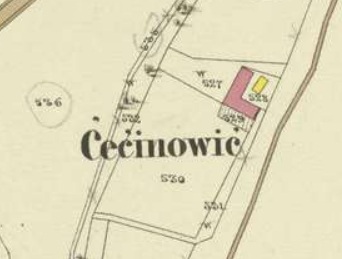 The
owner was Josef Csecsinovits (not a Batthyány) and, if you sound out the place name and the owner's surname, you'll likely
conclude they are phonetic twins. The
owner was Josef Csecsinovits (not a Batthyány) and, if you sound out the place name and the owner's surname, you'll likely
conclude they are phonetic twins.
Werner Stubits, in a message to me concerning last month's bit on the Mayerhofs, said about Cecinowic:
"...which for me is more sounding like a name, as I had a lot of Csacsinovics or similar found in the records.... so
maybe it is not a facility but a name?" I certainly agreed with Werner and commented back that "I now suspect this
was the original Croatian surname spelling, which was retained in the settlement name (even though the surname was modified
over time)."

We finally come to Abdeckerey (Haus 163), which might be the most interesting of all of these! First,
let's deal with the mundane... 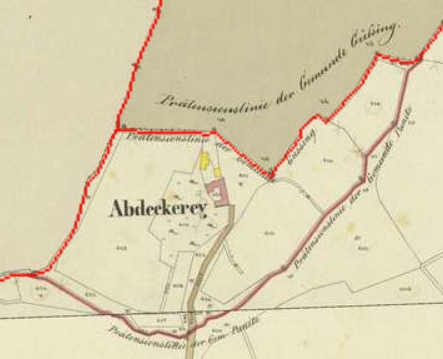 per
the Protocolle, this was not a Batthyány property so had no direct relationship to their Mayerhofs; instead,
it was owned by Josef Lutterschmeid. per
the Protocolle, this was not a Batthyány property so had no direct relationship to their Mayerhofs; instead,
it was owned by Josef Lutterschmeid.
Again, I am indebted to Werner Stubits for providing initial information about this facility.
He wrote: "You mention a place called Abdeckerey (= Abdeckerei) and I would like to clarify what is meant
by that: 'Abdecker,' in German the same as 'Wasenmeister,' was for centuries a job title for people who were
responsible for the disposal of animal carcasses and the rendering of carcasses in a certain district. The recycling
resulted in products such as fats, glue, bone meal, ammonia, soap, bleach and animal feed. As you might expect, it was a job
which was not very honored. (The) 'Abdeckerei' is the place where these activities took place, far from others because of
the stink."
Indeed! Abdeckerey is located on the northern border of the Güssing hotter, far from the "refined" noses of
the city folk! In fact, Abdeckerey was so much of a distant border feature that the tract of land it sat on was then
under dispute as to whether it belonged to the Güssing or the Punitz Gemeinde.
If you look at the map excerpt above, the red lines indicate the borders of the various village hotters, with Punitz
being the darker beige at the top center, Tobaj being the intermediate beige to the upper-left, and Güssing, in the lightest
beige, being the remaining, larger portion to the lower right of the red lines. However, there is also the magenta purple
line that circles below Abdeckerey and there is text printed along that line as well as along the red border line
between Güssing and Punitz.
The text along the purple line reads "Prätensionlinie der Gemeinde Punitz" while that along the red line reads "Prätensionlinie
der Gemeinde Güssing." Now, I have to confess that I had to look up what this meant, though first translating "Prätensionlinie"
to English: = pretension lines; and then looking up pretension (= a claim or assertion of a
claim to something). Then I found an online copy of a cadastral survey instruction book, where it notes
that Prätensionlinie are to be marked on the map indicating the extent of land in dispute between Gemeinden.
So, though nobody wanted the Abdeckerei close to their own city, ownership was apparently a different thing! However, poor
Tobaj village was, in fact, quite a bit closer to Abdeckerey ...and they, apparently, put no claim in for it!

That concludes my second romp through the named outlying facilities of the Güssing Gemeinde. With the
Protocolle (and help from my friends), I have been able to clarify which conscription numbers applied to which
facilities and to detect a number of obvious typos of conscription numbers or place names. While it was not always clear
which piece of information was in error when there was a conflict, when it was clear I corrected the entries in our
transcription; for the remainder I added a note about the conflict.
I now feel far less confused!

Correction to Civil Records Location for Unterschützen: I received notice through our affiliated Facebook
page that our "FS Films" (FamilySearch Films) directory page might be pointing to the wrong civil recording
location for Unterschützen (Alsó-Lövö)... and that proved to be true. Credit goes to Karl
Sarkozi for noticing the error—thanks Karl!
We originally determined recording locations for civil records by using information from the 1913 Hungarian Gazetteer
(A Magyar Szent Korona Országainak Helységnévtára = Gazetteer of the Countries of the Hungarian Holy Crown). We used
this edition because it was the only post-1895 Hungarian gazetteer on the net then, and that has led to some problems!
The nature of most of these problems is that recording locations did not remain static from 1895 to 1913, so some
locations listed in 1913 were different in 1895 (and, no doubt, some listed correctly in 1913 later became incorrect). Over
the years, we learned that there was a fairly major shuffling of recording location assignments in 1907... and some minor
changes in a few other years. Thus, every time I write one of these correction notices, I ask you readers to tell me
of any errors you find; please read this as a new request! While the rate of error correction has gone down, some
errors still remain, and Karl found one.
Karl noted that we listed Oberschützen (Felsö-Lövö) as civil recording
location for Unterschützen (Alsó-Lövö), whereas his eyes observed that the birth record for his grandfather
was in the Oberwart (Felsö-Ör) records... as well as numerous other Alsó-Lövö
births. This second part (numerous records from a given village) is usually a good hint that this is the correct recording
location for a particular village.
As always, I went back to the 1913 Gazetteer to confirm we had transcribed the correct location and, sure enough, it
said Felsö-Lövö. But then I went to the Felsö-Lövö record images and looked
for Alsó-Lövö entries around 1913... none! Jumping in chucks of records, I checked the whole 1895-1920 era... no
Alsó-Lövö entries. Reversing course, I went to the Oberwart (Felsö-Ör) record images and did a
similar jumping visual search... and found Alsó-Lövö entries at every stop. Clearly,
Oberwart was the correct location.
Since we first set up our FS Films pages, additional Hungarian gazetteers have made their way onto the net. Because I
was curious, I checked out the 1907 edition... it, too, had Felsö-Lövö listed as recording location for Unterschützen. So I
jumped back to the 1902 edition. Lo and behold, it had the right Felsö-Ör location (as did the 1900, 1898 and
1895 editions! I wanted to check forward in time to see if the official Gazetteers had corrected their error
but was unable to find an online edition in the 1914-1920 era, so I can't answer that question. But it remains clear that
the error crept in by the 1907 edition, a point in time when so many recording locations had changed. I won't speculate as
to why Unterschützen was messed up then but I will note that we will change our listings to correct the error, regardless of
cause.
Let me repeat my request above: Please notify us if you see an apparently incorrect recording location
listed. We will check it out and fix it if necessary. You'll be doing us a favor (we want things to be right!) and a
favor to all the researchers who walk in some of your footsteps (they won't have to follow those wrong paths too!). Thanks.

 Corona
Virus in Burgenland? This will be the last "edition" of this tidbit, as there is not much left to say about Covid-19
in Burgenland and in Austria. While it is still an important US topic, that has little to do with the mission of the
Burgenland Bunch, so it will go away, only to return if some important Covid-related event occurs in Burgenland. Corona
Virus in Burgenland? This will be the last "edition" of this tidbit, as there is not much left to say about Covid-19
in Burgenland and in Austria. While it is still an important US topic, that has little to do with the mission of the
Burgenland Bunch, so it will go away, only to return if some important Covid-related event occurs in Burgenland.
In this tidbit, I've tried to make a couple of things evident across my various "editions," one being that "flattening the
curve" is not the same as ending the epidemic; the other being that the epidemic was "local" in nature, starting
locally at different points in time, expanding at differing rates dependent on local population density and mitigation
efforts, and with the timing of eventual "reopening" being fully dependent on when it began locally and the local conditions
and mitigations.
As you know, I chose to use a type of graph for the Covid data whose strength was in showing when the "exponential growth"
of the epidemic ended. Thus it was with some surprise when I reviewed the Pennsylvania DOH (Department of Health) "Covid
Dashboard" mid-month, that I discovered that they had added a whole series of graphs that they called "trajectory"
plots that were of the style I have been using all along. I say "of the style" because the basic nature of their new graphs
is identical to the ones I had been using but differed in that they presented "3-day Rolling Average" data (or 7-day)
instead of the raw, daily data I used. The advantage of "rolling average" data is it smoothes out some of the daily
variability in the data, making the underlying behavior smoother and more evident. The disadvantage is that you need more
data, which I did not have when I first created my graphs.
The other thing that the PA DOH did in their graphs was to add separate lines for regions of PA (south-east,
north-east, south-central, north-central, south-west, south-east). Yep, they admitted that the epidemic was local in nature,
even in PA!
Here is their (June 9th) graph (slightly modified by me to improve labeling):
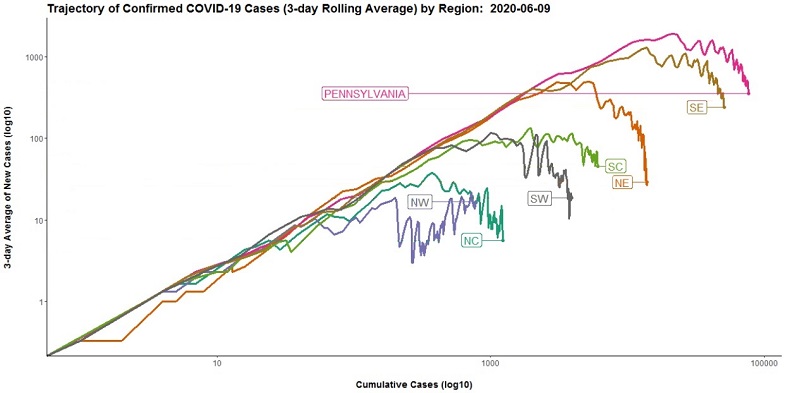
As you likely know, PA is shaped like a big rectangle, wider than tall; and the PA DOH regions divide it into 6 fairly-equal
geographic chunks. In the graph above, the magenta line stretching furthest to the upper-right corner is for the state as a
whole. The brown line up in the corner with the state line is for "south-east" PA—the Philadelphia area—and that region had
67% of all reported positive cases in the state. The next, reddish-brown line (when working down toward the lower-left
corner) is for "north-east" PA—the area of PA nearest the New York epicenter (and also the region that includes one of our
PA Burgenländer enclaves); it has 18% of PA's positive cases. One might expect that our next "hotspot" would be the
"south-west" region that contains Pittsburgh (another PA Burgenländer enclave), but it is not. Rather, "south-central" PA
(where I live) comes in third with 8% of the positive cases (in fact, its current number of daily new cases actually
exceeds that of the "north-east" region, as our epidemic started later). The "south-west"/Pittsburgh region is
fourth, with only 5% of PA's positive cases. The remaining "north-central" and "north-west" regions show only 2% and 1% of
the cases; however, "the north-west" region, headed by Erie, PA, has shown a recent up-tick in daily new positive cases—it
is the only PA region currently showing renewed exponential growth (they were among the first to have restrictions
relaxed... and they have since had some restrictions reinstated!).
But lets talk about Austria... Austria was hit relatively early in the pandemic and, correspondingly, are much ahead of us
in recovery. Here is the latest chart for Austria (through June 26):
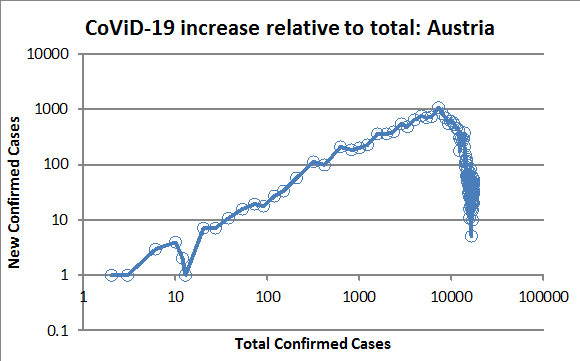
Again, it is essentially unchanged compared to last month, with new confirmed-case counts for Austria averaging about 31
per day this month. Clearly, Austria is continuing on a course to recovery.
In Burgenland, this has resulted in further relaxation of restrictions per new rules put in place on June 15th. There is
still a minimum distance rule (one meter) but mouth-nose protection is mandatory only in certain areas and for certain
people (mandatory in public transportation and pharmacies; in closed rooms if not at your assigned seat; for employees in
the catering trade; for all when the minimum distance cannot be maintained).
Given Austria's continuing recovery and return to normality, this will be my last update on this topic... as the Ghost of
Corona Present said, "If these shadows remain unaltered by the Future, none other of my newsletters will find this
update here."
I had planned to present my graphs for Pennsylvania and Minnesota one final time to see what impact opening their economies
had. However, it appears Pennsylvania has removed access to their raw data (at least I could not find it now). So
rather than present my own graph, I'll present the most-recent PA DOH "trajectory" plot and tell you to note the
"hook upward" at the end of the statewide trajectory line as well as for every regional line. That is, positive cases are
rising at a faster rate now towards the end of the month than they were 15 days ago. Of particular note, the Pittsburgh
("SW") area is showing the largest relative uptick and has responded by rescinding much of their recent "loosening" of
restrictions. While this is too short an interval to tell with any certainty that we have returned to exponential growth, it
does not look good.
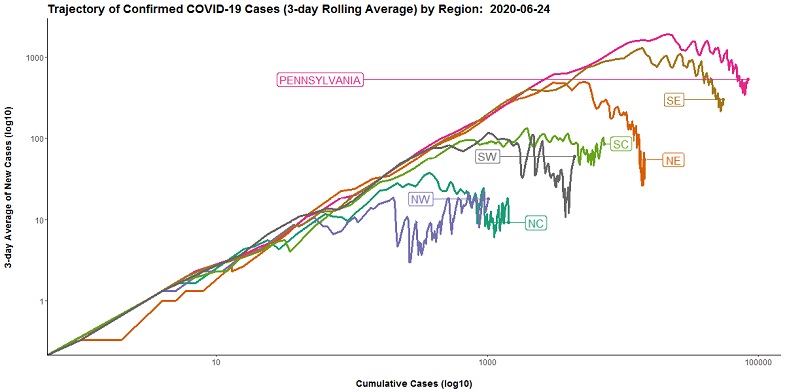
Minnesota, however, is still providing their raw data (data only through June 25, as they continue to have a delay of a few
days in "essentially complete" reporting):
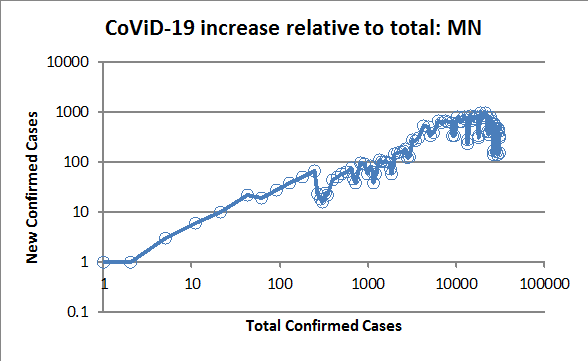
That plot continues to show a lot of sporadic data! Have they "fallen off" the exponential growth line? Yes, I think
so. Are they in a plateau or is the positive case rate falling? I can't tell! I do note that the "reopening" in
Minnesota has been quite conservative, only small steps so far, so a plateau makes sense. But will the continuing
relaxation of restrictions lead to a rebound? I would not bet against it!
So, that's my final report on this topic. The pandemic-related situation in Burgenland has largely reached a stable "new
normal" so I do not feel there is benefit in continuing these reports. Let's hope that does not change.

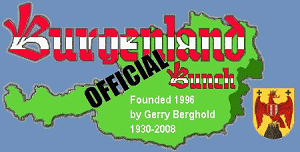 The
Facebook Bunch (from Vanessa Sandhu): The
Facebook Bunch (from Vanessa Sandhu):
Greetings Burgenland Bunch!
I hope that you are all staying safe and healthy! We had a great month in our Facebook group. We welcomed 35 new members,
bringing our total to 1340. Please consider joining us if you haven’t done so. We welcome everyone, and it is a great place
to learn and interact!
facebook.com/.../TheBurgenlandBunchOFFICIAL
New member Roland Schuller shared his fantastic YouTube channel, called “Polsen kocht pannonisch s’
Beste.” The channel features authentic old Burgenland recipes. The videos are in traditional Burgenland dialect, but
Roland has offered to translate the recipes for us. His videos include Bohnensterz, Linsen, Burgenländisch
Krautrouladen, and many more. Check it out, you will not be disappointed!
youtube.com/channel/...
Member Randy Heine shared an interesting story about his grandmother, Angelica Heine. She was born to Victoria
Deutsch, the head housekeeper at the Habsburg Palace. Family lore reported that Angelica was the illegitimate daughter of
Emperor Franz Joseph. Victoria was granted a farm in Grieselstein, Burgenland. Villagers knew of the situation and called
Angelica “the little princess.” She was reportedly visited by elites from Vienna that arrived in “big black carriages.” She
came to America in 1906. If anyone else is researching this family or has any knowledge of this situation, I’m sure that
Randy would love to compare notes!
In an effort to preserve the memories of our beloved ancestors, we have started an album on our group page to memorialize
them. The hope is that we will be able to transfer the images over to the Burgenländers Honored and Remembered
project when the project is ready for them.
Member Chris Wilkinson shared two of his excellent blogs this month. One is about the Leitha River and the
other discusses the Austro-Hungarian Empire. You can read them here:
The Leitha River:
the-first-frontier-leitha-river-austria-hungarys-internal-divide
The Austro-Hungarian Empire:
an-austro-hungarian-state-of-mind-bridge-on-the-leitha-together-one-last-time
Member Annette Kapple has started a DNA project for those with ancestors with the surnames of Koppel /
Kappel / Kapple at FamilyTreeDNA. This is the web address if anyone would like to join:
familytreedna.com/groups/koppel-kappel-kapple
That’s all for now! Be well and stay safe!
Vanessa

 Update
for book "The Burgenländer Emigration to America": Here is this month's update on purchases of the English issue of
the 3rd edition of Dr. Walter Dujmovits' book "Die Amerika-Wanderung Der Burgenländer." Update
for book "The Burgenländer Emigration to America": Here is this month's update on purchases of the English issue of
the 3rd edition of Dr. Walter Dujmovits' book "Die Amerika-Wanderung Der Burgenländer."
Current total sales are estimated to be 1531 copies, as interested people purchased 9 more books during this past
month. Sales are being estimated because our print-on-demand printer, Lulu.com, is still updating their site
and systems, thus the complete sales history is currently unavailable (but is expected to return in July). However, sales
during the current month are listed.
As always, the book remains available for online purchase at a list price of $7.41
(which is the production charge for the book, as we purposely choose not to make a profit so we can avoid dealing
with the income tax consequences and so you can obtain the book at as low a cost as possible!), plus tax & shipping.
See the BB homepage for a link to the information / ordering page and for information
about current discounts (there is at least one discount on price or shipping available most of the time... if not, wait a
few days and there will be one!). Getting the book and reading it is another excellent way to pass the time in self-imposed
quarantine.

Burgenland Recipes: Chris Jacobson lived only a few blocks away from her grandmother in
suburban Milwaukee, and they enjoyed cooking together. Although her grandmother's Christmas cookies were always the best,
this recipe is another one of her favorites. It's a bit of work, but Chris assures us that the results are superb.
 Rhubarb
Torte Rhubarb
Torte
Ingredients-crust:
1 cup butter
2 cup flour
2 egg yolks
3 Tbsp. sugar
dash salt
Ingredients-filling:
4 egg yolks
1 cup canned evaporated milk
2 cup sugar
4 Tbsp. flour
2 Tbsp. butter, melted
4 cup cut up rhubarb (buy about 1-3/4 lbs.)
Ingredients-meringue:
6 egg whites, room temperature
2 Tbsp. water
dash salt
1/2 tsp. cream of tartar
3/4 cup sugar
Preparation:
Start with 6 eggs, and have three teacups handy. Separate 2 eggs for the crust, putting the whites in one teacup and the
yolks in another. When separating the other 4 eggs for the filling, put the whites in the whites teacup, but put the yolks
separately in the third teacup.
Heat oven to 375 degrees. Combine crust ingredients until crumbly, press into bottom and sides of a greased 9x13 pan. Mix
filling ingredients and pour into crust. Bake 35 minutes until custard is set.
Reduce oven to 325 degrees. Beat egg whites, water and salt until frothy. Add cream of tartar, whip until stiff but not dry.
Add sugar one tablespoon at a time while continuing beating. Spread meringue on hot filling and bake 20 to 25 minutes or
until lightly browned. Enjoy.

 Note:
We have updated the recipes sortable list with links directly to the recipes or food-related
articles published in our past newsletters. You can access the list by clicking our recipe box (to the right). Thanks to the
contributions of our members over the years, we have quite a collection of Burgenland recipes, some with several variations. Note:
We have updated the recipes sortable list with links directly to the recipes or food-related
articles published in our past newsletters. You can access the list by clicking our recipe box (to the right). Thanks to the
contributions of our members over the years, we have quite a collection of Burgenland recipes, some with several variations.
However, we have now used up most of our unpublished recipes... thus this recipe section will become dormant when we run
out. So, if you have a favorite family recipe, please consider sharing it with us. We will be happy to publish it. Our older
relatives, sadly, aren't with us forever, so don't allow your favorite ethnic dish to be lost to future generations.
You can send your recipe to BB Recipes Editor,
Alan Varga. Thanks!

Cartoon of the Month:
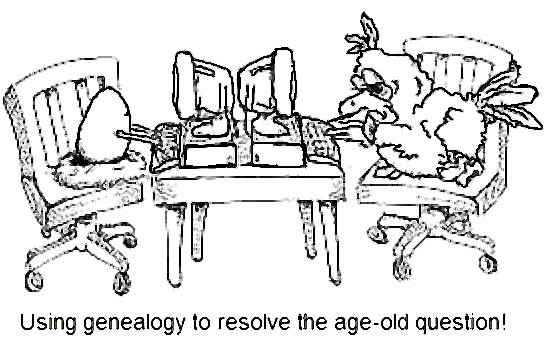
|
2) CULTURE, NOSTALGIA, AND MODERN MIGRATION – A CENTURY LATER:
A STUDY OF BURGENLÄNDERS AND THEIR DESCENDANTS
(by Patricia L. Nemetz-Mills, Ph. D, Eastern Washington University)
[Editorial note: Early this year the BB promoted (via this newsletter and our affiliated Facebook page)
participation in this study, so our membership is well-represented among the respondents to the study. As a result,
Professor Nemetz-Mills, the director of the study, offered to provide to us a report on the study and its results. This
article, less my comments in this editorial note, is that report.
If you participated in the study, you may recall that you were asked to look carefully at two photosets, to then rate, via a
seven-point agree/disagree scale, a series of statements about each photoset and, finally, to indicate which photoset you
preferred.
Although it was not stated as part of the survey materials, the images in the two photosets were carefully chosen to
characterize 1) the traditional Burgenländische culture and 2) a modern worldwide homogeneous culture.
The survey materials were provided in English- and German-language formats—the first intended for English-speakers,
 the
second for German-speakers residing in Burgenland and nearby locations. While the textual portions of the two survey
formats were designed to be as identical as possible, the photosets were designed to differ somewhat between the survey
formats in order to characterize better each culture with images familiar to the respondents. Thus the English-language
survey's "traditional culture" photoset used images from North American Burgenländische enclaves while the German-language
survey used images from Austria. The "modern culture" photosets were almost—but not quite—identical between
the surveys, differing only in continent-specific aspects of modern culture (for example, football vs. soccer). the
second for German-speakers residing in Burgenland and nearby locations. While the textual portions of the two survey
formats were designed to be as identical as possible, the photosets were designed to differ somewhat between the survey
formats in order to characterize better each culture with images familiar to the respondents. Thus the English-language
survey's "traditional culture" photoset used images from North American Burgenländische enclaves while the German-language
survey used images from Austria. The "modern culture" photosets were almost—but not quite—identical between
the surveys, differing only in continent-specific aspects of modern culture (for example, football vs. soccer).
The above was the first part of the survey. The second part was a group of statements about your feelings
about your current community of residence and about modern migration and its immigrants/emigrants, also
rated on a seven-point agree/disagree scale. The last part of the survey consisted of demographic questions.
In general, the agree/disagree statements in surveys of this type are typically intended to be somewhat redundant, probing
for a small number of key ideas in slightly differing ways. Doing so, allows the researcher to see if she is getting
consistent, informative responses (versus unusable, random-choice responses). If the responses are consistent, the
researcher can use statistical methods to group the similar questions and compute a single "score" for each key idea. As you
will see in the report, five key ideas (called "factors" in the report) were extracted and "scored" from the first part of
the study (two of those key ideas were based each on only a single agree/disagree statement). Likewise, three key ideas were
extracted and "scored" from the second part of the survey (each idea being about particular aspects of your feelings about
modern migration).
The report explains the eight derived factors (scores) and summarizes these and the demographic variables (residency, age,
gender). It then turns to the three main questions the study was designed to explore.
The first question asks whether European respondents (Burgenland-area, German-speaking) differ from the
English-speaking respondents (emigrants and offspring of emigrants) in regard to the eight derived factors.
The second question asks whether cultural orientation affects feelings about modern migration.
The third question then asks whether demographic differences affect feelings about modern migration.
Professor Nemetz-Mills concludes her report in a short discussion section that places context around her results, noting
that this is but a first step in exploring questions of this nature.
While I would hope that the results observed in this sample of volunteer respondents would also hold in wider groups of
Burgenländers and the Burgenländische English-speaking diaspora, it is hard to say we respondents were a
"fully-representative" subset of the wider groups. Given our memberships in Burgenländische genealogical/historical groups,
we are likely inclined to be more interested in traditional culture than the general public—likely more nostalgic
about it too. And, given our knowledge of the migratory hardships of our own ancestors, we are also likely more "welcoming'"
to modern migrants than others might be. However, this study did not explore how we compare to those wider groups, so my
statements here remain only conjectures.The text below is the main body of Professor Nemetz-Mills' report.
The full report includes two appendices that I have converted to pdf files and include only as links herein; if you
are interested in those details, follow the links where they appear in report.]

CULTURE, NOSTALGIA, AND MODERN MIGRATION – A CENTURY LATER:
A STUDY OF BURGENLÄNDERS AND THEIR DESCENDANTS
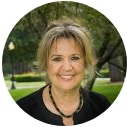 - Patricia Nemetz-Mills
- Patricia Nemetz-Mills
FOREWORD
This research sought the opinions of Burgenländers and those whose ancestors came from Burgenland. It represents one type of
update to research reported in The Burgenländer Emigration to America (Dujmovits, 2013). The data provide a
survey-style overview of opinions about current migration as a supplement to the many interesting anecdotes and historical
accounts and records found in genealogical research. For this research, many survey respondents were members of the
Burgenland Bunch, the Austrian Society for Research on Genealogy and Regional Heritage (ÖFR),
Ahnenforschung Burgenland, Ahnenforschung in Ungarn, Das Alte Burgenland, Mia Hianzen, and/or the
Hungarian-American Genealogical Society. Their participation is deeply appreciated. Special thanks go to Thomas
Steichen, who was very helpful in so many ways. Thanks are also sent to Vanessa Bammer Sandhu, Leopold Josef Strenn and
Patrick Kovacs, who were instrumental in legitimizing the project in a way that made respondents comfortable with
participating in the survey. Special thanks also goes to Eastern Washington University, which funded the professional leave
necessary to conduct the research.
EXECUTIVE SUMMARY
This report summarizes opinions of Burgenländers in Europe and descendants of Burgenländers who emigrated in the 19th and
20th centuries, referred to hereafter as Burgenland’s diaspora.* There were 216 participants, 41 from Europe and 173
from other parts of the world (mostly the United States).
* "Diaspora" traditionally referred to Jewish exiles from ancestral Israel; modern usage refers to
permanent émigrés from any ethnic group.
Three main questions were the subject of study:
1. Do Europeans differ from the diaspora in their cultural orientation and feelings about modern (current) migration?
2. How do Cultural Orientations (Traditional Cultural Orientation** and Modern Cultural Orientation),
Nostalgia, Financial Security, and Technological Change affect one’s feelings about modern Migration (Immigration’s
Societal Effect, Immigration’s Personal Effect, and Emigration)?
3. What demographic factors affect one’s feelings about modern Migration?
** Capitalized Italic words represent the names for factors measured in the research; Capitalized
non-italic words represent groupings of measured factors.
Here are the major findings of the research:
1. Respondents were more oriented to photos depicting traditional culture than to those depicting modern culture, which
is often characterized as “globalization.” Europeans were even more comfortable with traditional culture than the
diaspora.
2. Overall, respondents were relatively positive about the societal and personal effects of current immigration. European
respondents were slightly less positive than others, but still positive. This is perhaps understandable given the high
number of undocumented migrants entering the European continent in recent decades.
3. Respondents from the diaspora, however, had more sadness about current emigration, possibly related to the shrinking
population of some domestic communities. Ongoing structural change in the economy of the United States may be part of the
reason for those shrinking communities, which were built on the industrial backbone of the 20th century economy.
4. The factors that had the most influence on feelings about Immigration’s Societal Effect were Cultural
Orientation and the belief that Technological Change was affecting communities more than immigration.
a. Modern Cultural Orientation led to more positive feelings about Immigration’s Societal Effect.
b. Strong feelings that technology is changing communities more than immigration led to more positive feelings about
Immigration’s Societal Effect.
5. The factors that had the most influence on feelings about Immigration’s Personal Effect were Technological
Change, Financial Security, Age, and European residency.
a. Strong feelings that technology is changing communities more than immigration led to more positive feelings about
Immigration’s Personal Effect.
b. Respondents who felt financially secure had more positive feelings about Immigration’s Personal Effect than
those who felt less financially secure.
c. Increasing Age and European residency led to slightly more negative feelings about Immigration’s
Personal Effect.
6. Feelings about Emigration were most strongly affected by Nostalgia and Gender. Women and
respondents with high feelings of evoked Nostalgia expressed more sadness about Emigration.
Overall, there was a measured and mature response to feelings about current migration from the respondent group. This
snapshot in time documents beliefs of Burgenländers several generations after large numbers of Burgenländers left their
homeland. Adaptation to modern society is evident in the data, but many respondents retain a love for their old traditions
and experience nostalgia for their traditional culture in modern times.
INTRODUCTION
Online survey research, administered between January and April, 2020, sought the opinion of Burgenländers in Europe and
descendants of Burgenländers who emigrated in the 19th and 20th centuries. Many internal Burgenländische migrants settled in
Vienna or Budapest, while most Burgenländische emigrants settled in the United States, Canada, Germany, South America,
Australia, or New Zealand, with the greatest number settling in the United States (Dujmovits, 2013).
The context of the research was situated in a timeframe when globalization and immigration were at the forefront of concerns
around the world. In 2015, more than one million wartime migrants, asylum seekers, and economic refugees from the Middle
East, Africa, and western Asia entered or transited Burgenland along the Austrian-Hungarian border (Bundesministerium
Europa, 2019; Guardian, 2019; Saleem, 2018; Sanderson, 2020; Walt, 2019). Many Eastern Europeans from former Communist
states had also sought settlement in Austria between 1989 and 2020 (Adams, 2019; Guardian, 2019). Across the Atlantic,
immigration to the United States was raising a specter of concern, as it had sporadically done in previous decades during
other waves of immigration. Election polls in 2016 suggested issues related to undocumented immigration and domestic
dispersion of population from old industrial communities were issues highly influential with many voters (Cox, Lienesch,
Jones, 2017). In many parts of the world, the idea of “globalization” as a detriment to the preservation of unique cultural
and economic well-being had been a concern since the institution of several trade agreements (Barber, 1992; Collins, 2012;
Vance, 2016). The motivation for the research, therefore, was to learn how current Burgenländische residents and the
Burgenland diaspora were responding to concerns about modern migration around the world.
SURVEY
Surveys with different cultural photosets were created through an iterative process in which knowledgeable participants
provided feedback and choices until final photosets had consensus agreement about their cultural representativeness.
Cultures were defined by family structure, food, clothing, entertainment, buildings, gender roles, religion, important
institutions, work life, and educational practice. Two different surveys were created—one for diaspora respondents in
English, and one for Burgenland respondents in German. Each survey is shown in
Appendix I. The first photoset in each survey represents culture strongly
associated with, and particular to, Burgenländische traditions. The second photoset in each survey represents modern
globalization, which has a high degree of cultural homogenization or similarity around the world. (One survey respondent was
horrified by the inclusion of McDonald’s in one of the photos. That photo was purposely chosen as a representation of
cultural homogenization. No brands are more ubiquitous around the world than McDonald’s and Coke. Those brands are often
used in textbooks that explore globalization, and McDonald’s is often used as an icon of cultural hegemony—does the Great
Wall of China really need a McDonald’s restaurant at its feet?). German photosets differed from English photosets, though
the photos for modern globalization showed slighter differences than traditional photosets due to cultural homogenization
(sometimes called harmonization in Europe). Most German photosets were chosen from Austrian sources in order to be
representative of culture likely to be familiar to Austrian respondents. Most English photosets were chosen from North
American locations.
Questions about nostalgia, immigration and demographics were then chosen based on other polling questions and academic
studies. The German survey was translated from English, then back-translated by a German-speaker to ensure the accuracy of
the translation. Surveys were reviewed by Eastern Washington University’s Institutional Review Board to ensure they avoided
any harm to participants. They were then posted on SurveyMonkey so they could be conveniently answered anonymously
and voluntarily online.
SAMPLE
The research commenced just before the COVID-19 Pandemic and its associated stay-at-home orders, so it was somewhat abruptly
halted for practical reasons. Nevertheless, enough respondents (n=216) participated in the research to find interesting
statistical results. The sample size of European respondents (n=41) might be a bit small to claim a valid representative
sample, so a replicated study in the future (well after the passing of the pandemic) might be in order for those interested
in tracking longitudinal beliefs and values as part of their genealogical studies.
A total of 216 respondents answered all or part of the survey. Of the 216 respondents, 173 answered as members of the
diaspora, and 41 as non-immigrant European inhabitants. Of those who identified their diaspora residency, most listed places
in the United States, but 3 listed Canada, 2 listed Australia, 1 listed New Zealand, and 1 listed Germany. Of the diaspora
group who listed which generation emigrated, 4 listed themselves, 21 listed parents, uncles or aunts, 61 listed
grandparents, 33 listed great-grandparents, and the remainder listed great-great-grandparents or earlier, so the sample is
multigenerational-immigrant. The majority of respondents were between 46 and 75 years of age, and 58% were men. Table 1
summarizes the frequencies of demographic variables.
Table 1
Frequencies for Demographic Variables
|
|
|
N |
Percent |
|
|
N |
Percent |
|
Residency |
|
|
|
Age |
|
|
|
|
|
Diaspora |
173 |
81 |
|
18-30 |
5 |
2.3 |
|
|
Europe |
41 |
19 |
|
31-45 |
19 |
8.8 |
|
Gender |
|
|
|
|
46-60 |
50 |
23.3 |
|
|
Male |
125 |
58.1 |
|
61-75 |
95 |
44.2 |
|
|
Female |
75 |
34.9 |
|
Over 75 |
31 |
14.4 |
ANALYSIS AND MEASURES
For readers with an analytic, mathematical, or statistical orientation, full statistical analyses are included in
Appendix II. Because such reading is turgid and
difficult, analyses are briefly explained here, with the understanding that only statements based on statistical validation
are presented as evidence. Furthermore, as with all statistical analytics, there is a small probability that random error is
present in the results. In keeping with academic practices, that probability is kept to 5% or less in reported results, with
many reported results well below that probability of error.
Measures used for analyses were derived from data provided by respondents for each survey item. They are described below.
Cultural Orientation – Factor analysis of the survey shows statistical consistency in Traditional Cultural
Orientation and Modern Cultural Orientation. Respondents with a Traditional Cultural Orientation tended to
agree with the following statements about the first (traditional) photoset, while those with a Modern Cultural
Orientation tended to agree with the same statements about the second (modern) photoset:
|
Makes me feel secure in my personal relationships |
|
Gives me a sense of belonging |
|
Makes me feel financially secure |
|
Makes me feel like I will always have close friends and
family members |
|
Gives me an opportunity to be myself without judgment from
others |
|
Feels exciting or adventurous |
|
Feels familiar or comfortable |
|
I understand and identify with the lifestyle depicted here |
Cultural Orientation scores were calculated from the above response items, where 1 is low agreement and 7 is high
agreement for that particular Cultural Orientation (Traditional or Modern). Scores greater than 4 indicate a
positive response for that Cultural Orientation. Participants were also asked which photoset they preferred. Table 2
summarizes their choices and associated mean scores for Cultural Orientation. Most respondents preferred the traditional set
(56%), or both sets equally (24%). Only 10% preferred the modern set, and 7 percent did not care for either, but even those
with a modern photoset preference were positive about the traditional photos.
Table 2
Scores by Photo Set Preference
|
Photo Set Preference |
N |
Percent |
Traditional Cultural Orientation
Mean Score |
Modern Cultural Orientation
Mean Score |
|
Traditional |
120 |
56 |
5.0925 |
3.7009 |
|
Modern |
21 |
10 |
4.4048 |
4.1369 |
|
Both |
51 |
24 |
4.5662 |
4.8227 |
|
Neither |
15 |
7 |
3.8929 |
3.7667 |
Nostalgia – Respondents who had high levels of evoked Nostalgia tended to agree with the following
statements about the traditional photoset:
|
Makes me feel nostalgic |
|
Evokes fond memories |
|
Reminds me of the good old days |
|
Is a pleasant reminder of the past |
|
Makes me reminisce about a previous time |
|
Helps me recall pleasant memories |
The sample tended to have high levels of evoked Nostalgia, with a mean score of 5.63 (out of 7) for all
respondents.
Financial Security and Technological Change – Single items measuring Financial Security and feelings about
Technological Change were designed to be noninvasive. The sample as a whole tended to have high levels of agreement with
the following statements, with a mean score of 5.58 (out of 7) for Financial Security, and 5.35 for Technological
Change:
|
I feel financially secure |
|
Technology is changing my community more than immigration |
Immigration and Emigration – Analysis of items asking about migration found three factors where responses were
internally consistent. Scores were developed from these items, where 1 is low agreement and 7 is high agreement with the
statements. The first factor can be described as feelings about Immigration’s Societal Effect. Respondents with a
high score on Immigration’s Societal Effect tended to agree with the following statements (some items were reversed
scored because they were purposely listed opposite on the survey):
|
Illegal or undocumented immigration doesn’t bother me |
|
I am not concerned that immigrants are changing my
community |
|
Immigrants are good for the economy |
|
Immigrants improve my financial condition |
|
Immigrants don’t threaten my way of life |
|
Immigrants from unfamiliar places don’t tend to increase
crime |
The second factor can be described as feelings about Immigration’s Personal Effects, or how it affects the
respondent personally or on a daily basis. Respondent’s with a high score on Immigration’s Personal Effect tended to
agree with the following statements:
|
I don’t mind immigrants from faraway places, even
non-Europeans |
|
I don’t mind working with non-European immigrants |
|
I’d feel fine if someone in my family marries an immigrant |
|
I don’t mind when someone with an accent waits on me or
serves me |
|
Immigrants do a good job in the workplace |
The third factor can be described as feelings about Emigration, or migration away from the respondent’s current
community. It can apply to either international emigration or domestic mobility. Respondents with a high score on
Emigration tended to agree with the following statements:
|
I feel sad when close friends and family move to another
place |
|
I miss my close friends and family |
|
Friends and family leaving my community upsets me more
than immigration |
The sample as a whole was relatively positive about Immigration’s Effects, with a mean score of 4.7 (out of 7) for
Immigration’s Societal Effect and a mean score of 5.63 for Immigration’s Personal Effects. Respondents also
expressed relatively high sadness or upset when members of the community leave their community, with a mean score of 5.21
for Emigration. The difference in Immigration scores at the Societal and Personal levels might be attributable to
some response bias at the personal level, with respondents reluctant to express personal negative feelings about immigration
or immigrants. On the other hand, the results may also be due to one of the remedies often suggested as a means of improving
relations with unfamiliar others—getting to know someone at a personal level can improve international and inter-ethnic
relations.
Table 3 summarizes these results, which are the mean computed scores and other descriptive statistics for each of the
factors for the sample.
Table 3
Summary Results
|
|
N |
Minimum* |
Maximum* |
Mean* |
Std. Deviation |
|
Traditional Cultural Orientation |
206 |
1.88 |
7.00 |
4.80 |
.997 |
|
Modern Cultural Orientation |
210 |
1.00 |
7.00 |
4.03 |
1.081 |
|
Nostalgia |
207 |
2.00 |
7.00 |
5.63 |
1.055 |
|
Financial Security |
196 |
1.00 |
7.00 |
5.58 |
1.388 |
|
Technological Change |
198 |
1.00 |
7.00 |
5.35 |
1.520 |
|
Immigration’s Societal Effect |
204 |
1.17 |
7.00 |
4.70 |
1.304 |
|
Immigration’s Personal Effect |
201 |
1.50 |
7.00 |
5.63 |
1.011 |
|
Emigration |
201 |
1.00 |
7.00 |
5.21 |
.989 |
* 1=Strongly Disagree 2=Disagree
3=Slightly Disagree 4=Neither Agree Nor Disagree 5=Slightly Agree 6=Agree 7=Strongly Agree
RESEARCH QUESTION RESULTS
Several questions were of interest when the research was developed. Each question and the results are reported in the next
section.
Do Europeans differ from Diaspora Members in their Cultural Orientation and Feelings about Migration?
Table 4 illustrates results for answering this question. Numbers that are bolded and shown with an asterisk indicate
statistically significant differences. Differences between Europeans and Diaspora members exist in Modern Cultural
Orientation, feelings about Immigration’s Societal Effect, feelings about Immigration’s Personal Effect,
and feelings about Emigration. Differences about Traditional Cultural Orientation and Nostalgia are not
statistically significant. Europeans tend to have less of a Modern Cultural Orientation (mean = 3.71) than members of
the Burgenland diaspora (mean = 4.10). Europeans, though slightly positive about Immigration overall, are less positive than
diaspora members about Immigration’s Societal Effect (mean = 4.00 vs. mean = 4.79) and Immigration’s Personal
Effect (mean = 5.14 vs. mean = 5.73). Diaspora members, however, are more concerned about community Emigration
(mean = 5.29) than Europeans (mean = 4.83).
Table 4
European and Diaspora Differences
for Cultural Orientation and Migration Feelings
|
Cultural Orientation |
Community |
N |
Mean |
Std. Dev. |
|
Traditional Cultural Orientation |
Diaspora |
166 |
4.78 |
.974 |
|
European |
39 |
4.89 |
1.108 |
|
Modern Cultural Orientation |
Diaspora |
169 |
4.10* |
1.070 |
|
European |
40 |
3.71* |
1.095 |
|
Nostalgia |
Diaspora |
167 |
5.64 |
1.007 |
|
European |
39 |
5.56 |
1.262 |
|
Migration |
|
|
|
|
|
Immigration’s Societal Effect |
Diaspora |
166 |
4.79* |
1.200 |
|
European |
37 |
4.00* |
1.261 |
|
Immigration’s Personal Effect |
Diaspora |
164 |
5.73* |
.966 |
|
European |
36 |
5.14* |
1.096 |
|
Emigration |
Diaspora |
164 |
5.29* |
.952 |
|
European |
36 |
4.83* |
1.088 |
How do Cultural Orientation, Nostalgia, Financial Security, and feelings about Technological Change affect one’s feelings
about Migration?
Table 5 summarizes which factors emerged as the most relevant influences on feelings about Migration. Cultural Orientation
for this research was defined as comfort levels with traditional life and/or modern life, whereas nostalgia was defined as
“as a bittersweet emotion in which an idealized past is viewed with both sadness and longing” (Davis 1979, Starobinski 1966,
Stewart 1984). Financial Security was measured by one’s feeling of financial security, and Technological Change
was measured by one’s feeling that technology is changing the community more than immigration.
One’s feeling about Immigration was most strongly influenced by Technological Change and Cultural Orientation.
Respondents with a strong belief that technology was changing their community more than immigration had more positive
feelings about both immigration effects (Immigration’s Societal Effect; Immigration’s Personal Effect) than
respondents who did not feel as much Technological Change. Respondents with a Modern Cultural Orientation had
more positive feelings about Immigration’s Societal Effect, while those with a Traditional Cultural Orientation
had opposite feelings. Nostalgia did not influence feelings about immigration, but it had a strong effect on one’s
sadness about Emigration from the community, as did the belief that technology was changing one’s community.
Financial Security was most influential on feelings about Immigration’s Personal Effect. Those who felt more
Financial Security had more positive feelings about Immigration’s Personal Effect than those who felt less
Financial Security.
Table 5
Effects of
Cultural Orientation, Nostalgia, Financial Security, and Technological Change
on Feelings About Immigration and Emigration
|
Regression No. |
Immigration and Emigration |
Influence Factors |
Direction of Relationship |
|
1 |
Immigration’s Societal Effect |
Technological Change |
Positive |
|
Traditional Cultural Orientation |
Negative |
|
Modern Cultural Orientation |
Positive |
|
|
|
2 |
Immigration’s Personal Effect |
Technological Change |
Positive |
|
European |
Negative |
|
Age |
Negative |
|
Financial Security |
Positive |
|
|
|
3 |
Emigration |
Female |
Negative |
|
Technological Change |
Negative |
|
Nostalgia |
Negative |
What Demographic Factors affect one’s Feeling about Migration?
Demographic factors had relatively small effects on feelings about Migration. Table 5 lists Age, Gender, and
being European as three demographic factors that had a small effect. Being European had a slight negative
influence on feelings about Immigration’s Personal Effects, and increasing Age led to slightly more negative
feelings about Immigration’s Personal Effects. For feelings about Emigration, women felt more sadness than men
about members leaving their communities.
DISCUSSION
The question of migration poses many complexities, and one’s feelings about immigration and emigration are equally complex.
This research can only begin to disentangle all the complexities involved with one’s feelings about migration. Those
feelings, whether positive or negative, deserve validation and understanding. Researchers concerned about migration often
wonder if it is the hard financial consequences of modern migration that create controversies, or if it is the softer and
harder-to-define issues of cultural displacement that rankle a population. Confidence in understanding more about migration
will take many more years of study among many different populations, but there are some inklings of information that emerged
from this research. Cultural orientation, technological change, and financial security all have some effect on feelings
about immigration, and nostalgia is part of the sadness about emigration and shrinking communities.
One important finding of the research is that the feelings of Burgenländische populations about immigration and emigration
are relatively well-modulated (measured, mature, thoughtful) at this point in time. Though there was a good range of
responses on the scales measuring feelings about migration, the sample as a whole was relatively agreeable about various
aspects of immigration. Larger population groups in Europe and the United States may be in more upheaval about immigration,
but that was not widely manifested in this group. Hints of concern exist, but hyperbole and overwhelming angst about
immigration were not evident. In Europe, there was slightly more concern about the societal and personal effects of
immigration than among the diaspora. Perhaps this is understandable, given recent waves of immigration throughout the
continent. For a long time, Burgenland was part of an enormous multicultural and multilinguistic empire, so it has history
with diversity. One cannot discount, however, the impact of horrific wars as empires collapsed and nations fought for
primacy in the face of diversity. Austria’s prosperity and stability has been a hallmark of its existence for the last few
decades, and threats to that wonderful state of calm should not be taken lightly. In the United States, the Burgenländische
diaspora’s response was equally well-modulated. Its concerns were less about immigration, and more about the loss of
community. The relatively high financial well-being of many in the diaspora may be a cushion against harsh feelings toward
immigrants, but there exists some feeling of nostalgia and loss for that distinct Burgenländische culture that bound its
first communities together. At the same time, those nations that are nations of immigrants eventually come to realize that
communities are constantly re-making themselves with new peoples and new cultures. It appears that many of the respondents
are comfortable with one foot in each world—the traditional and the modern. The riptides of technology and mobility are
pulling at communities, and many respondents seem to understand that change in their communities is often coming from
technology and the fact that Burgenländers are dispersing out of their original communities or hometowns by choice. There
seems to be a realization that change is inevitable.
APPENDICES (links)
Appendix I: Surveys
Appendix II: Full statistical analyses
REFERENCES
Adams, J. (2019) Eastern Europe’s Emigration Crisis, Quillette. Retrieved 25 Feb 2020 from
https://quillette.com/2019/06/29/eastern-europes-emigration-crisis/
Barber, B. J. (1992) Jihad vs. McWorld. Atlantic Monthly, 269(3): 53-63.
________ Bundesministerium Europa, Integration und Äußeres (2019). Migration und Integration. Statistik Austria.
Retrieved 2 Mar 2020 from
https://www.bmeia.gv.at/.../Migration-Integration-2019.pdf
Collins, G. (2012) As Texas goes...How the lone star state hijacked the American agenda. Liveright.
Cox, D., Lienesch, R., & Jones, R. P. (2017) Beyond Economics: Fears of Cultural Displacement Pushed the White Working
Class to Trump | PRRI/The Atlantic Report, Public Religion Research Institute. Retrieved 5 Jul 2017 from
https://www.prri.org/research/white-working-class-attitudes-economy-trade-immigration-election-donald-trump/
Davis, Fred (1979), Yearning for Yesterday: A Sociology of Nostalgia, New York: Free Press.
Dujmovits, W., (trans.) Strauch R. (2013) The Burgenländer Emigration to America (English Issue), 3rd Ed. The
Burgenland Bunch and Lulu Press, Inc.
_______ Gallup in-depth topics: A to Z. (2019). Immigration. Retrieved 12 Nov 2019 from
https://news.gallup.com/poll/1660/immigration.aspx
_______ Guardian (2019) Europe's south and east worry more about emigration than immigration - poll. Retrieved 3 Jan
2020 from
https://www.theguardian.com/world/2019/apr/01/europe-south-and-east-worry-more-about-emigration-than-immigration-poll
Pascal, Vincent J., David E. Sprott, and Darrel D. Muehling (2002), “The Influence of Evoked Nostalgia on Consumers'
Responses to Advertising: An Exploratory Study,” Journal of Current Issues and Research in Advertising, 24 (1),
39-49.
Saleem, A. (2018, Nov. 19) The changing face of Austria’s asylum policies. Retrieved 10 March 2020 from
https://www.infomigrants.net/en/post/13242/the-changing-face-of-austria-s-asylum-policies
Sanderson, S. (2020, Jan. 3) What does Austria’s new governing coalition mean for migrants? Retrieved 10 Mar 2020 from
https://www.infomigrants.net/en/post/21878/what-does-austria-s-new-governing-coalition-mean-for-migrants
Starobinski, Jean (1966), 'The Idea of Nostalgia," Diogenes, 54 (Summer), 81-103.
Stewart, Susan (1984), On Longing: Narratives of the Miniature, the Gigantic, the Souvenir, the Collection.
Baltimore, MD: Johns Hopkins University Press.
Vance, J. D. (2016) Hillbilly Elegy: A memoir of a family and culture in crisis. HarperCollins.
________ World Values Survey Website (2020). Retrieved 2 Jan 2020 from
http://www.worldvaluessurvey.org/wvs.jsp
Walt, V. (2019, Apr 22) How Nationalists Are Joining Together to Tear Europe Apart. Time.
|
 Well,
we are not virus free yet... in fact, in many places we are worse off now than a month ago, as the inevitable rise in cases
has followed the reopening of economies and the rebellion against face masks by the "it's all about me" crowd. I'll throw
out an opinion here: I do think we need to reopen the economy in a sensible way ...but I also think face masks should
be mandatory in every indoor public space (including private places open to the public) and that those spaces should
be required to have hand-sanitizer dispensers near high-touch areas. We need income, but we must look out for
each other too [end of mini manifesto].
Well,
we are not virus free yet... in fact, in many places we are worse off now than a month ago, as the inevitable rise in cases
has followed the reopening of economies and the rebellion against face masks by the "it's all about me" crowd. I'll throw
out an opinion here: I do think we need to reopen the economy in a sensible way ...but I also think face masks should
be mandatory in every indoor public space (including private places open to the public) and that those spaces should
be required to have hand-sanitizer dispensers near high-touch areas. We need income, but we must look out for
each other too [end of mini manifesto]. But
let me start dispelling my confusion by speaking about the Parzellen Protocolle...
But
let me start dispelling my confusion by speaking about the Parzellen Protocolle... the
second for German-speakers residing in Burgenland and nearby locations. While the textual portions of the two survey
formats were designed to be as identical as possible, the photosets were designed to differ somewhat between the survey
formats in order to characterize better each culture with images familiar to the respondents. Thus the English-language
survey's "traditional culture" photoset used images from North American Burgenländische enclaves while the German-language
survey used images from Austria. The "modern culture" photosets were almost—but not quite—identical between
the surveys, differing only in continent-specific aspects of modern culture (for example, football vs. soccer).
the
second for German-speakers residing in Burgenland and nearby locations. While the textual portions of the two survey
formats were designed to be as identical as possible, the photosets were designed to differ somewhat between the survey
formats in order to characterize better each culture with images familiar to the respondents. Thus the English-language
survey's "traditional culture" photoset used images from North American Burgenländische enclaves while the German-language
survey used images from Austria. The "modern culture" photosets were almost—but not quite—identical between
the surveys, differing only in continent-specific aspects of modern culture (for example, football vs. soccer). During the second Turkish
invasion in the 17th century, the Turks kidnapped children as they traveled toward the gates of Vienna (some children could
also be from "the door of Vienna"). They used these children as cow herders, milk maids, etc. When the Turks retreated and
had no further need for the children, they abandoned them. The children were nameless and no one knew where they came from.
The Hungarians called them "tschidas" or "csidas" which means "man on a horse" or "rider,"
referring to these Turkish horsemen.
During the second Turkish
invasion in the 17th century, the Turks kidnapped children as they traveled toward the gates of Vienna (some children could
also be from "the door of Vienna"). They used these children as cow herders, milk maids, etc. When the Turks retreated and
had no further need for the children, they abandoned them. The children were nameless and no one knew where they came from.
The Hungarians called them "tschidas" or "csidas" which means "man on a horse" or "rider,"
referring to these Turkish horsemen.
 Gisela Haviland, age 78 of Marion,
Ohio, passed away Friday, June 5, 2020 at the Bellevue Hosptial.
Gisela Haviland, age 78 of Marion,
Ohio, passed away Friday, June 5, 2020 at the Bellevue Hosptial. Christine Bendekovits, 63, of
Bethlehem, Pennsylvania, passed away peacefully on Wednesday, June 24, 2020 at Lehigh Valley Hospital-Muhlenberg.
Christine Bendekovits, 63, of
Bethlehem, Pennsylvania, passed away peacefully on Wednesday, June 24, 2020 at Lehigh Valley Hospital-Muhlenberg. News
News
 Next,
there are Haus numbers 147 to 150.
Next,
there are Haus numbers 147 to 150.
 I can
only conclude that it was a non-residential building, possibly a stable or riding arena serviced by staff lodged in the
nearby building labeled Mayerhof.
I can
only conclude that it was a non-residential building, possibly a stable or riding arena serviced by staff lodged in the
nearby building labeled Mayerhof. The
owner was Josef Csecsinovits (not a Batthyány) and, if you sound out the place name and the owner's surname, you'll likely
conclude they are phonetic twins.
The
owner was Josef Csecsinovits (not a Batthyány) and, if you sound out the place name and the owner's surname, you'll likely
conclude they are phonetic twins. per
the Protocolle, this was not a Batthyány property so had no direct relationship to their Mayerhofs; instead,
it was owned by Josef Lutterschmeid.
per
the Protocolle, this was not a Batthyány property so had no direct relationship to their Mayerhofs; instead,
it was owned by Josef Lutterschmeid.  Corona
Virus in Burgenland? This will be the last "edition" of this tidbit, as there is not much left to say about Covid-19
in Burgenland and in Austria. While it is still an important US topic, that has little to do with the mission of the
Burgenland Bunch, so it will go away, only to return if some important Covid-related event occurs in Burgenland.
Corona
Virus in Burgenland? This will be the last "edition" of this tidbit, as there is not much left to say about Covid-19
in Burgenland and in Austria. While it is still an important US topic, that has little to do with the mission of the
Burgenland Bunch, so it will go away, only to return if some important Covid-related event occurs in Burgenland.



 The
Facebook Bunch (from Vanessa Sandhu):
The
Facebook Bunch (from Vanessa Sandhu): Update
for book "The Burgenländer Emigration to America": Here is this month's update on purchases of the English issue of
the 3rd edition of Dr. Walter Dujmovits' book "Die Amerika-Wanderung Der Burgenländer."
Update
for book "The Burgenländer Emigration to America": Here is this month's update on purchases of the English issue of
the 3rd edition of Dr. Walter Dujmovits' book "Die Amerika-Wanderung Der Burgenländer." Rhubarb
Torte
Rhubarb
Torte

 - Patricia Nemetz-Mills
- Patricia Nemetz-Mills